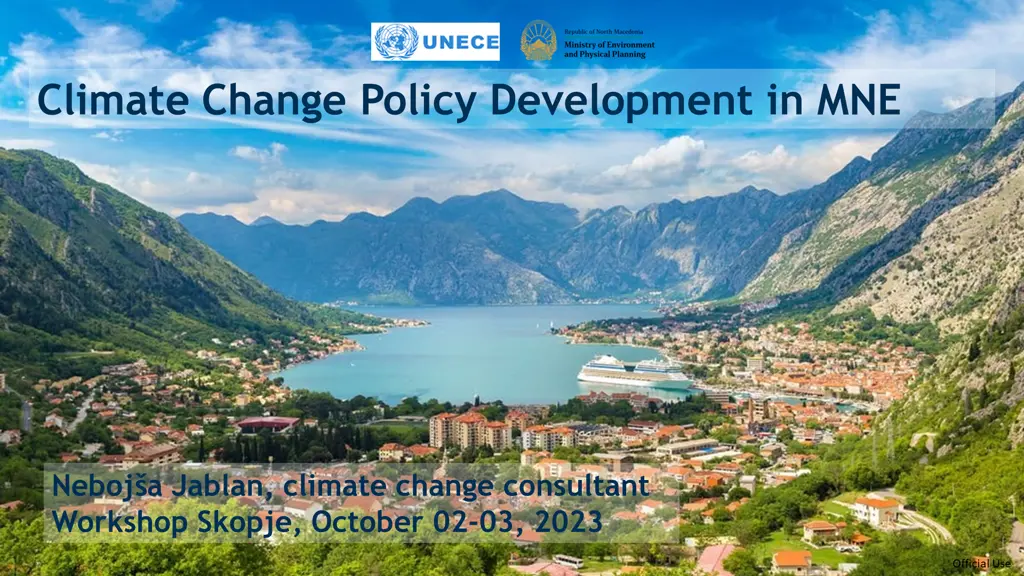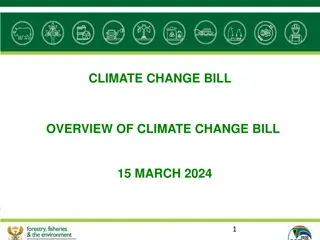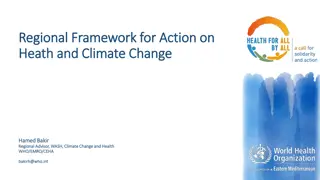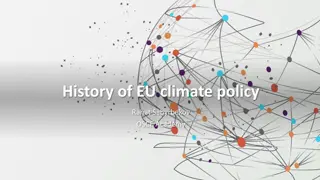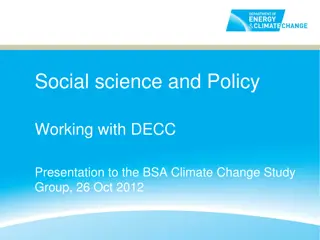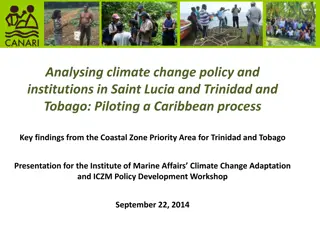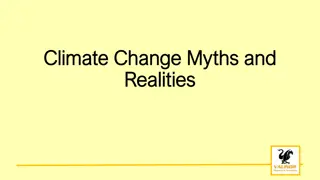Climate Change Policy Development in MNE
The implementation of climate change policies in Montenegro, including the preparation of the updated Nationally Determined Contribution (NDC) and the integration of climate change risks into the planning process.
Download Presentation

Please find below an Image/Link to download the presentation.
The content on the website is provided AS IS for your information and personal use only. It may not be sold, licensed, or shared on other websites without obtaining consent from the author. Download presentation by click this link. If you encounter any issues during the download, it is possible that the publisher has removed the file from their server.
E N D
Presentation Transcript
Climate Change Policy Development in MNE Neboj a Jablan, climate change consultant Workshop Skopje, October 02-03, 2023 Official Use
Implementation of obligations under the Paris Agreement Report for the preparation of the updated Nationally Determined Contribution (NDC) from 2020, committing to reduce greenhouse gas emissions by 35% compared to the base year 1990 The new target set by the Energy Community is to reduce GHG emissions by 55% until 2030 GEF-financed Biennial Transparency Report (BTR) and Fourth National Communication project. Update the GHG inventory 1990-2021, increasing transparency in the field of climate change Working on the implementation of the GEF-financed project Strengthening Montenegro's Nationally Determined Contribution (NDC) and Adaptation Activities Transparency Framework CBIT CBIT improves data to increase transparency, strengthens the capacity of national institutions responsible for policies and measures in the area of mitigation and adaptation, as well as institutions in charge of collecting data for GHG inventory and preparing national reports on the inventory. Development of a fully operational national system for monitoring, reporting and verification (MRV), including a clear definition of the roles and responsibilities of all the relevant stakeholders, fully developed methodologies, procedures and guidelines (MPG) for the various elements of the system, as well as a web portal providing all the necessary information related to mitigation, inventory of greenhouse gas emissions (GHG), financing of activities in the area of climate change, etc. Official Use
Enhancing Montenegros capacity to integrate climate change risks into the planning process Development of the National Climate Change Adaptation Plan-NAP financed by the Green Climate Fund (GCF) Vulnerability and assessment of risk, impact of climate change and adaptation measures to climate change in the field of meteorology and hydrology, developed by the Hydro-Met Institute The project covers four sectors which are most vulnerable to adaptation: water, health, tourism and agriculture and defines adaptation measures for priority sectors. NAP with the Action Plan will be adopted by the end of 2023 The project also helped redesigning and positioning of the National Council for Sustainable Development (NCSD) by providing technical support and capacity building. NCSD is a national platform to facilitate sustainable development, chaired by the PM and contains of 7 WG (Climate Change WG and Just Transition WG are the most proactive) TRATOLOW capacity building programme, ADAPT, TAIEX The World Bank Group has approved funds for the development of the Low-Carbon Development Strategy, which will enable the development of models, scenarios for the period from 2030 to 2050, as well as parallel consultations with stakeholders, which is due by the end of 2025 The MCI is currently developing the Law on Renewables, due in Dec. 2023 The MCI is currently developing the Integrated National Energy and Climate Plan (NECP), due in June 2024 Official Use
National legislation National Climate Change Strategy 2015-2030, to be replaced by NECP (2030) and LCDS (2050), once both strategies adopted Law on Protection from the Negative Impacts of Climate Change (2019) By-law regulations 3 decrees and 12 rulebooks (2020/2021) Regulation on activities that emit greenhouse gases for which a permit for the emission of greenhouse gases is issued (2020) the national system of CO2 compensation as an efficient mechanism of low-carbon development The Ministry of Ecology, Spatial Planning and Urbanism has started work on drafting a new Law on Protection from the Negative Impacts of Climate Change and Protection of the Ozone Layer, which transposes the following: Regulation (EU) 2018/2066, Regulation (EU) 2018/2067, Regulation (EU) 2018/1999 on the Governance of the Energy Union and Climate Action, Delegated Regulation 2020/1044 supplementing Regulation 2018/1999, Implementing Regulation (EU) 2020/1208, Regulation (EU) 2018/841 and Regulation (EU) 2018/842 1. 2. 3. 4. 5. Official Use
Achieving low-carbon development Low-Carbon Development Strategy 2050 LCDS National Adaptation Plan (NAP) Obligations of the stationary plant operator Method and content for issuing a permit Permit request Obligations of aircraft operators Reporting on emissions and verification of reports Data management, control and records GHG inventory management CO2 emissions from new passenger vehicles
ETS goals Emission credit = tCO2 emission The allocation of emission credits is carried out by the Government by conducting a public auction or free allocation The minimum price is 24 / tCO2 The Environmental Protection Fund (Eco-fund) keeps the register Decision on the formation of the Commission for conducting a public auction for the allocation of emission credits Funds collected on the basis of a public auction Eco fund finance projects in the field of environmental protection and climate change Reduction of greenhouse gas emissions at the national level Gradual adaptation of domestic operators to the EU working conditions The funds based on emission credits, collected by the Eco Fund and the annual GHG levels are the key indicators for the fulfillment of the system goals Official Use
PMI Carbon pricing project I Impact assessment of carbon pricing: assessment of carbon pricing impact to improve understanding of the implications of the EU ETS, the CBAM, and any non-ETS CPI deployed by Montenegro on changes in energy use and GHG emissions, on costs for firms and consumers, and on socio- economic and distributional (including just transition) issues evaluation of the interactions of carbon pricing on generation planning of Electric Power Utility of MNE (EPCG), the coal-fired TPP a high-level assessment of potential synergies between carbon pricing and the forestry and tourism sectors Analytical work to support the enhancement of carbon pricing policy and legal-regulatory framework, including: further update of the existing national carbon pricing scheme until full compliance with the Energy Community acquis, introduction of the EU ETS and CBAM, including analysis of the potential expansion to other sectors (buildings, transport) domestic carbon offset scheme in the forestry sector, including evaluation of the design options for the domestic crediting mechanism and development of the implementation plan carbon tax design (with focus on transport sector) including the national policy evaluation and options analysis and regulatory requirements for the carbon tax Official Use
PMI Carbon pricing project II Cross-cutting activities: technical assistance to the state institutions, private companies, Eco Fund and other key players involved in carbon pricing implementation (for compliance with the EU ETS and CBAM) technical support to the national installations for joining the EU ETS linking carbon pricing with the GHG MRV system for emissions trading support in developing a communications strategy to generate public acceptability and awareness of carbon pricing collaborating and communicating with international project delivery teams and other stakeholders Stakeholders: Stakeholder engagement and consultation: mapping of relevant stakeholder groups to be engaged throughout the carbon pricing policy development process Planning the meetings with the relevant stakeholders Status of the council, working group, etc Official Use
PMI Carbon pricing project III Cross-cutting activities: Communications plan: development and implementation of a communications strategy/campaign Capacity building and Training: development of needs assessment and strategy, design and delivery of capacity development work program Knowledge management: determine and implement a knowledge management strategy/plan to support and enhance the carbon pricing policy development and implementation cycle Implementation arrangements: MESPU: coordination and decision-making mechanism, MRV system WB: provision of analytical studies and reports, cooperation with the MESPU and other stakeholders Official Use
SDG 13: Take urgent action to combat climate change and its impacts Targets and indicators Target 13.1 Strengthen resilience and adaptive capacity to climate-related hazards and natural disasters in all countries Indicator 13.1.1 Number of deaths, missing persons and directly affected persons attributed to disasters per 100,000 population Indicator 13.1.2 Number of countries that adopt and implement national disaster risk reduction strategies in line with the Sendai Framework for Disaster Risk Reduction 2015 2030 Indicator 13.1.3 Proportion of local governments that adopt and implement local disaster risk reduction strategies in line with national disaster risk reduction strategies Target 13.2 Integrate climate change measures into national policies, strategies and planning Indicator 13.2.1 Number of countries with nationally determined contributions, long-term strategies, national adaptation plans, strategies as reported in adaptation communications and national communications Indicator 13.2.2 Total greenhouse gas emissions per year Target 13.3 Improve education, awareness-raising and human and institutional capacity on climate change mitigation, adaptation, impact reduction and early warning Indicator13.3.1 Extent to which (i) global citizenship education and (ii) education for sustainable development are mainstreamed in (a) national education policies; (b) curricula; (c) teacher education; and (d) student assessment Target 13.a Implement the commitment undertaken by developed-country parties to the UNFCCC to a goal of mobilizing jointly $100 billion annually by 2020 from all sources to address the needs of developing countries in the context of meaningful mitigation actions and transparency on implementation and fully operationalize the Green Climate Fund through its capitalization as soon as possible Indicator 13.a.1 Amounts provided and mobilized in United States dollars per year in relation to the continued existing collective mobilization goal of the $100 billion commitment through to 2025 Target 13.b Promote mechanisms for raising capacity for effective climate change-related planning and management in least developed countries and small island developing States, including focusing on women, youth and local and marginalized communities Indicator 13.b.1 Number of least developed countries and small island developing States with nationally determined contributions, long- term strategies, national adaptation plans, strategies as reported in adaptation communications and national communications https://www.sdgmontenegro.me/en/13/ Official Use
Thanks a lot for your attention! Questions? Official Use
